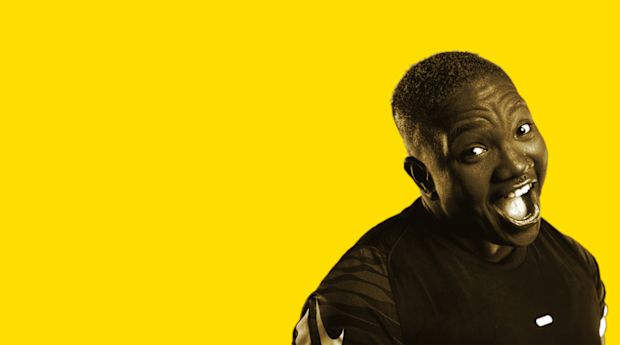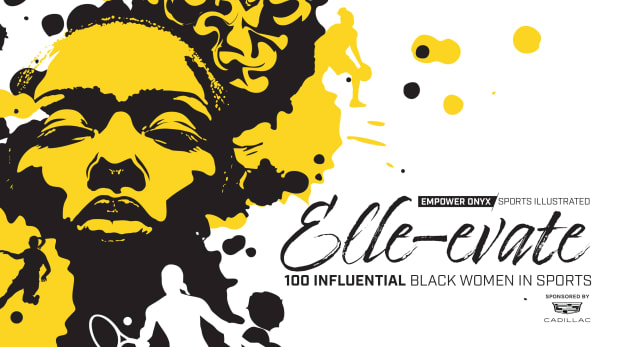The shot put star reflects on her journey to the global stage and her hopes for other athletes like her to see themselves competing at the Olympics.

Sports Illustrated and Empower Onyx are putting the spotlight on the diverse journeys of Black women across sports—from the veteran athletes, to up-and-coming stars, coaches, executives and more—in the series, Elle-evate: 100 Influential Black Women in Sports.
Two-time Olympian and track and field superstar Raven Saunders is used to all of the attention. A 5’5” queer, Black woman, the self-proclaimed “Hulk” had to defy the odds to become one of the most prolific shot putters in recent Olympic history. She gained the world’s attention at the 2020 Tokyo Olympics when she took to the winner’s podium to receive her silver medal and threw up her arms in an X, honoring “the intersection where all oppressed peoples meet,” she says. Now well into her athletic career and life in the public eye, the record-breaking medalist and mental health advocate reflects on her journey, as well as her hopes for the future of Black queer women in the Olympics.
Raised in Charleston, S.C., Saunders was breaking records locally long before her Olympic debut in Rio. She set the all-time national girls shot put record before she graduated high school, broke South Carolina’s shot put record by 11 feet and went on to break the women’s NCAA indoor record in February 2015 for the longest indoor or outdoor throw ever by a female collegiate athlete.
When she missed the medal podium at her first Olympics in 2016, Saunders says her mental health started to spiral, something she was open about at the time.
“When you look at me as a person you say, ‘They’re so strong. They’re so motivated.’ But I was almost giving up on my life,” Saunders says. “Internally, it was hard being a person that was so strong, but so weak and vulnerable in that moment. It was so bittersweet, because I almost gave up, and I'm like, ‘Yo, how could I do that?’”
She credits her position in the world as a queer, Black woman with anchoring her. Being forced to prove her worth over and over solidified Saunders in her purpose. Repetition turned into a mantra, and that mantra morphed into her reality.
“Track and field has literally mirrored my life’s journey. I wasn’t someone that was looked at or cared about—I was gay, Black, chunky. I didn’t fit the mold of people that would be seen as important. But I looked at it like, if I was going to be a shot putter, I was going to be the best, and the world was going know that. I’m gonna find my way, and y’all are gonna make some room for this wide load right here, coming through,” Saunders says.
Outsports reported that there were around 185 queer athletes competing at the Tokyo Olympics, a record high for the community, but just a fraction of the 11,500 athletes who competed in total. Once again forced into the spotlight and representing marginalized groups on the global stage, Saunders welcomed the attention. She knows what her visibility would mean to other Black, queer women and girls, particularly other masculine-presenting lesbians; she wanted to be seen so they could see themselves.
“My body is my body, and I present how I present. I’m not the type to go into these meets and wear makeup, or go super crazy. But there are different things that are unique about me. I like to go crazy with my hair. I like jewelry. I like to be very external in my celebrations,” Saunders says. “It’s just something that I wanted people to see, because I figured that there were so many other people that didn’t see that in themselves, in sports, especially in women’s sports.”
Perhaps the hardest part—and one of the driving factors in Saunders’s career—was the lack of, well, anyone who looked like her in the Olympics.
“It was really hard, especially as a Black, queer woman, no, we weren’t there. Black women, yes, I can name a hundred of them,” Saunders says. “But I was like, what about us short athletes? What about dark-skinned women? Where are the thicker women?”
Though she may not have had many Black, queer shot put icons to look up to, the Black women representing the diaspora around her globally served as inspiration and motivation—and even provided solace. She looked to iconic athletes such as the women of Team Jamaica as pillars of self-expression, which was some of the motivation behind her signature hair colors. “It was like, O.K., what can I do differently? Being on a world stage as a junior and watching the Jamaicans come in with the green and yellow, every time, never failed. Watching people like Shelly-Ann [Fraser-Pryce] and all of them go through as pros and seeing them being able to express themselves, it just gave me that much more confidence,” Saunders says. “This is something that no one can take away from me; it’s not a part of the uniform. It’s a way that I can show the world who Raven is, partially.”
Saunders became a silver medalist at the 2020 Olympics, throwing a distance of 64 feet, 11 inches. After taking her place on the podium and raising her arms in an “X,” she added, “Shout out to all my Black people. Shout out to all my LGBTQ community. Shout out to all my people dealing with mental health. … We understand that there’s so many people that are looking up to us, that are looking to see if we say something or if we speak up for them.”
After some response from the public, the International Olympic Committee launched an investigation to determine whether Saunders’s “X” gesture violated the rules of “prohibiting propaganda in an Olympic site.” (The United States Olympic Committee defended her, saying that the act did not breach its rules and was instead a “peaceful expression in support of racial and social justice that was respectful of her competitors.”)
With some time away from the incident, Saunders is as enthusiastic and unapologetic as ever—she would do it all over again to make those same people feel seen, even for just a moment.
“I had just secured a contract beforehand, had just met with Nike. At the time I was really still poor. In my mind, I knew that I could literally lose everything, but I understood that this moment was bigger than just me and whatever happened to me. If 10 people could take that message and run with it, better yet, the 10 million people that were watching, it was worth every single cent of it,” Saunders says. “Accomplishing that after all that I had been through, was bigger than this silver object. I am so happy I did it. I’m looking back to that young Raven and saying, like, I hope I'm making you really proud.”
The investigation was officially suspended in August 2021, at the same time that Saunders lost her mother, Clarissa. Saunders was remarkably vulnerable about her mental health struggles during that time, being brutally honest about what she needed.
“After the Olympics, after everything with my mom and my family, I got to a point where I was like, Yeah, I’m not doing this. I’m outta here. I’ll be back, but catch me on the flip side. Just being able to take that time for yourself. Because at some point, if you don’t, you are going to crash and we’ve witnessed that so much, especially with Black athletes. People see them exploding and they’re like, Oh, what is wrong with this person? But you don’t look at all the things that led up to that. No one wants to see or acknowledge any of it,” Saunders says.
Watching fellow competitors like Naomi Osaka and Simone Biles take time off to prioritize their mental health reinforced her determination to be an advocate for other Black women around her battling depression and even suicidal ideation.
“Once you reach a certain level, it's been demanded of us to be the best, and it's expected, nothing less. If you give anything less than that, then you're the worst. Seeing Black women take that power, I'm like, ‘Yes. Kudos to you.’ Especially when you need it—because nobody can ever tell you what you do and don't need,” Saunders says.
Now, she’s focusing her power on shaping the future of sports, and she can see it all clearly—it’s Black, queer, fat, masc, femme, trans, remorseless, unashamed, defiant. By not only providing representation but also being a fierce advocate for mental health awareness, Saunders is carving out room for a long line of athletes who feel seen, supported and understood.
“I want us to finally just, whoever you are, be comfortable being yourself, especially as queer women in this space. When you look at like the ’80s and ’90s of how these women had to hide their sexual identities, how many missed us now being able to be ourselves. I want them to know that it’s okay to be yourself. People will embrace you. You don’t have to hide it. It’s going to be O.K. When you do it, it is the greatest feeling,” Saunders says.

Naya Samuel is a contributor for Empower Onyx, a diverse multi-channel platform celebrating the stories and transformative power of sports for Black women and girls.